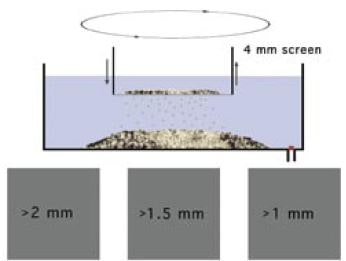6.3.6 Grading and estimating spat
Mechanical graders are available from specialist equipment suppliers and they are applicable when millions of seed are being handled on a routine basis. Otherwise hand graders are used in the majority of cases. These can easily be made as a series of large diameter (>30 cm) fibreglass or PVC pipe sections with nylon or plastic meshes of various aperture sizes fixed to one cut face.
Spat grading is best done in water. The grading screens, each marked with the size of mesh, should fit comfortably within a plastic tray fitted with a stopper or drain valve at one end. The tray is part-filled with seawater when in use. Small numbers of spat are added to a screen of a mesh size slightly smaller than the largest individuals. The sieve is then shaken from side to side and up and down in the water until no more spat escape through the mesh (Figure 95). More spat are added periodically until all have been graded through that screen. Those retained in the sieve will need to be removed from time to time to maintain efficiency of the process. They are transferred to a screen of known (tare) weight with the same mesh size and are left dry to await estimation.
The tray is then emptied and the smaller seed recovered for further grading. The procedure is then repeated with a screen of the next smaller mesh aperture, and so on.

Figure 95: Grading of spat with hand-held sieves (screens) in shallow tanks. The grading screen is rotated from side to side and up and down in the tank until all spat smaller than can be retained on the mesh fall through and collect at the base of the tank. Once grading with a particular screen is complete, the tank is drained into a receiving screen of appropriate mesh size, marked with the grade size of the spat. In this example, spat smaller than 4 mm mesh retention size will be collected in a 1 mm receiving container (of small enough mesh size to collect all that remain). The process continues with grading screens of decreasing mesh size until all spat have been fractionated into the various grade sizes.
Once separated by grade, the next task is to determine the biomass of spat in each grade. Screens containing the different grades need to be allowed to thoroughly drain until the contained spat are “damp dry.” Draining can be accelerated by dabbing the bottom mesh of the screens with dry clothes or paper towelling until excess water has been removed. The screens are then weighed and the weight of the screen itself subtracted to provide the weight of spat it contains. This is the biomass of spat of that particular grade.
At the same time, numbers of spat and a check on survival can be made. Numbers can be estimated either by weight or volumetrically. The former method requires accurate balances while the latter can be achieved with simple apparatus, e.g. small plastic containers of between 1 and 5 ml volume to hold sub-samples. This method will be described.
From the screen containing the largest sized seed, fill three sub-sample containers to the brim. Empty one into a shallow white tray containing a little seawater. A Petri dish marked with a grid, observed under a low power microscope is useful for counting very small spat. Count the total number of seed in the sub-sample. If there is no dark spot within the shells (the digestive system) or if the shells are gaping open, place to one side. Record the total number of seed and the number dead. Repeat for the second and third sub-sample. Determine the total volume of spat of that grade by transferring them to graduated containers and reading the volume they occupy. From this information, the total number alive and percentage mortality can be calculated as follows:
Example:
Basic information:
Sub-sample volume = 2 ml
Sub-sample 1: 865 total, 33 dead;
Sub-sample 2: 944 total, 41 dead;
Sub-sample 3: 871 total, 33 dead.
Total volume of seed (including the 3 sub-samples) in the grade = 1 850 ml
Calculation:
Average number of seed (live & dead) per 2 ml sub-sample
= (865 + 944 + 871)/3 = 893
Average number of dead per 2 ml sub-sample
= (33 + 41 + 33)/3 = 36
Mortality = (36/893)x100 = 9.6%
Estimated total number alive = (893 – 36)x(1 850/2) = 792 725
Numbers in the other grade fractions are estimated in the same way. Smaller volume sub-samples will be necessary for the smallest seed sizes.
Estimating numbers by weight follows the same basic method with small sub-samples taken for accurate weighing from the bulk of spat in the particular grade(s). Numbers in the weighed sub-samples are counted. Once the total weight of spat in the grade has been determined, total numbers can be calculated as above.
Spat of the various clam species are more difficult to grade than oysters because of their habit of attaching to one another and to the meshes and internal surfaces of the containers in which they are grown by byssus threads. Nevertheless they are handled in similar manner using water jets from a pressurized hose to separate them during the grading process.